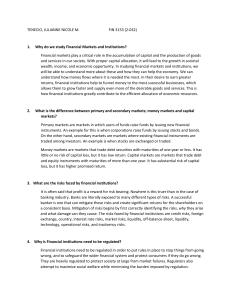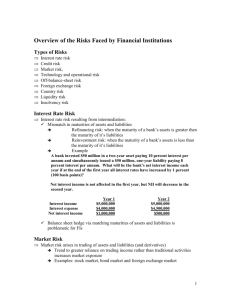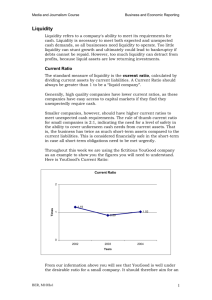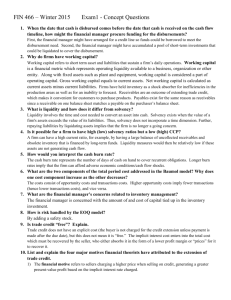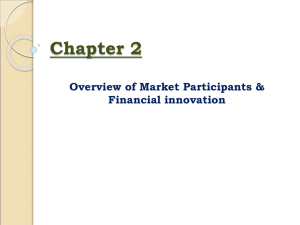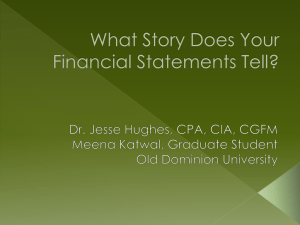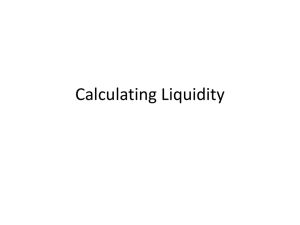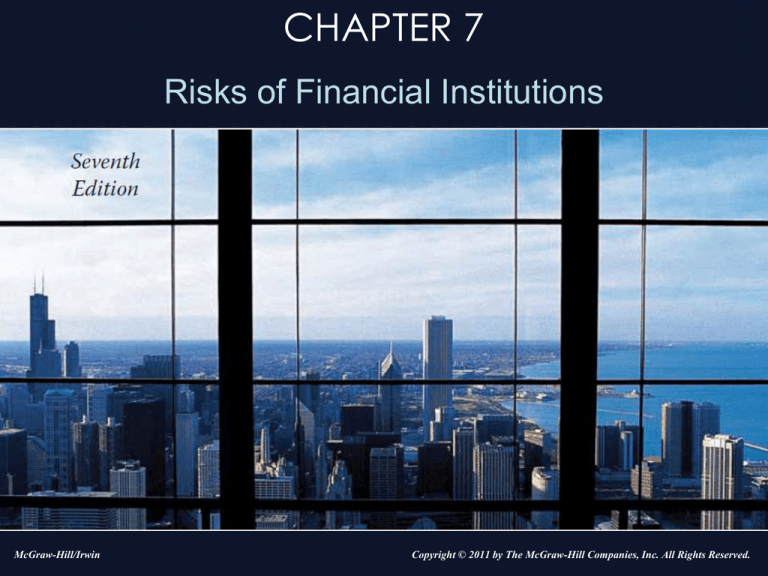
CHAPTER 7
Risks of Financial Institutions
McGraw-Hill/Irwin
Copyright © 2011 by The McGraw-Hill Companies, Inc. All Rights Reserved.
Overview
This chapter discusses the risks faced by
financial institutions:
– Interest rate risk, market risk, credit
risk, off-balance-sheet risk, foreign
exchange risk, country or sovereign
risk, technology risk, operational risk,
liquidity risk, and insolvency risk
Note: These risks are not unique to FIs
– Faced by all global firms
7-2
Risks of Financial Intermediation
Interest rate risk resulting from
mismatch in asset & liability maturities:
Spread changes as interest rates change
Since value = PV(Cash flows), equity affected
– Balance sheet hedge via matching
maturities of assets and liabilities is
problematic for FIs
Inconsistent with asset transformation role
– Refinancing risk
– Reinvestment risk
7-3
Market Risk
Incurred in trading of assets and
liabilities (and derivatives)
– Short view of time horizon
– Value at risk (VAR), daily earnings at risk
(DEAR)
Market meltdown 2008-2009
– Mortgage backed securities
– “Toxic” assets
– Lehman Brothers, Merrill Lynch, AIG
7-4
Market Risk
Market, or trading, risk present
whenever an FI takes an open or
unhedged long or short position in
securities or foreign exchange
Implications for regulators and
management:
– Need for controls
– Need for measurement of risk exposure
7-5
Credit Risk
Risk that promised cash flows are not
paid in full
High rate of charge-offs of debt in the
1980s, most of the 1990s and 2000s
Charge-offs continued to grow until
late 2008
Firm specific credit risk
Systematic credit risk
7-6
Charge-Off Rates for Commercial Banks
7-7
Implications of Growing Credit Risk
Importance of credit screening &
monitoring
Role for dynamic adjustment of credit
risk premiums
Diversification of credit risk
7-8
Off-Balance-Sheet Risk
Striking growth of off-balance-sheet
activities
– Letters of credit
– Loan commitments
– Derivative positions
Speculative activities using offbalance-sheet items create
considerable risk
7-9
Foreign Exchange Risk
FI may be net long or net short in various
currencies
Returns on foreign and domestic investment
are not perfectly correlated
FX rates may not be correlated
– Example: $/€ may be increasing while $/¥
decreasing and relationship between ¥ and €
time varying
Undiversified foreign exposure creates FX risk
7-10
Foreign Exchange Risk
Note that completely hedging foreign
exposure by matching foreign assets
and liabilities requires matching the
maturities as well*
– Otherwise, exposure to foreign interest
rate risk remains
*More correctly, FI must match durations, rather than
maturities. See Chapter 9.
7-11
Country or Sovereign Risk
Result of exposure to foreign
government which may impose
restrictions on repayments to foreigners
Often lack usual recourse via court
system
Examples:
– Russia
– Argentina
7-12
Country or Sovereign Risk
In the event of restrictions,
reschedulings, or outright prohibition of
repayments, an FI’s remaining
bargaining chip is future supply of
loans
– Weak position if currency collapsing or
government failing
7-13
Technology and Operational Risk
Risk of losses resulting from inadequate
or failed internal processes, people
and systems, or from external events
–
–
–
–
Loss of backup files by BOA
Unsecured wireless network at TJX
Jerome Kerviel (Société Générale)
Bernie Madoff
7-14
Technology Risk
Technological innovation has seen
rapid growth
– Automated clearing houses (ACH)
– CHIPS
– Real time interconnection of global FIs via
satellite systems
7-15
Technology and Operational Risk
Economies of scale
Economies of scope
Operational risk not exclusively
technological
– Employee fraud and errors
– Losses magnified since they affect
reputation and future potential
7-16
Liquidity Risk
Risk of being forced to borrow or sell
assets in a very short period of time
– Low prices result
May generate runs
– Runs may turn liquidity problem into
solvency problem
Failure of IndyMac in summer of 2008
7-17
Insolvency Risk
Risk of insufficient capital to offset
sudden decline in value of assets
relative to liabilities
Original cause may be excessive
interest rate, market, credit, offbalance-sheet, technological, FX,
sovereign, and liquidity risks
Washington Mutual
“Too big to fail” (e.g., Citigroup)
7-18
Other Risks & Interaction of Risks
– Interdependencies among risks
Example: Interest rates and credit risk
Interest rates and derivative
counterparty risk
– Discrete Risks
Examples include effects of war or
terrorist acts, market crashes, theft, and
malfeasance
Changes in regulatory policy
7-19
Pertinent Websites
Bank for International www.bis.org
Settlements
www.federalreserve.gov
Federal Reserve
www.fdic.gov
Federal Deposit
Insurance
Corporation
7-20

